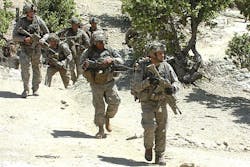DARPA seeks technologies to improve infantry effectiveness against unseen, unconventional enemy
ARLINGTON, Va., 26 Feb. 2015. U.S. military researchers are asking industry to find news ways to make small units of infantry warfighters more effectively and deadly using existing weapons and unmanned systems.
Officials of the U.S. Defense Advanced Research Projects Agency (DARPA) in Arlington, Va., released a broad agency announcement this week (DARPA-BAA-15-26) for the Squad X Core Technologies (SXCT) program to enhance warfighter situational awareness.
The SXCT program's goal is to develop new technologies that give infantry squads of eight to 14 members increased situational awareness, as well as improved capabilities in precision engagement, non-kinetic engagement, squad sensing, and squad autonomy.
U.S. infantry rifle squads today lack 21st century combat power, DARPA official say. They do not have the ability to switch from offensive and defensive operations to stability operations and back again, which can produce a high number of casualties.
With these disadvantages, today's infantry warfighter faces an adversary that on its own terrain has ubiquitous communications, hides in the terrain or culture, and follows different rules of engagement. The result is that U.S. military squads have less situational awareness than their adversaries, with sensing limited by line of sight and narrow fields of view.
To rectify problems, the DARPA SXCT advanced technology program seeks to develop capabilities that enhance the dismounted rifle squad’s situational awareness, as well as to build combat power to enable rifle squads to adapt to a broad range of military operations.
The SXCT program has four technology thrusts: precision engagement, non-kinetic engagement, squad sensing, and squad autonomy. Precision engagement seeks to enable the rifle squad to engage threats precisely out to 1,000 meters while maintaining compatibility with infantry weapon systems and human factors limitations.
story continues below
DARPA wants to develop technologies that help enable the rifle squad to engage known-but-unseen threats with new kinds of guided weapons that are compatible with current squad equipment like the M203/M320 grenade launchers or the Picatinny Rail system.
Researchers particularly are interested in a micro-missile or advanced 40-millimeter grenade that can engage unseen targets with precision using the networked squad, small unmanned vehicles, data-fusion-enabled shared situational awareness.
Non-kinetic engagement seeks to enable the rifle squad to disrupt enemy command, control, and communications with capabilities like electronic warfare, cyber warfare, and optical warfare. This approach also seeks to use unmanned assets to ranges greater than 300 meters while maneuvering at a normal squad pace.
Related: DARPA eyes sensors, communications, and data processing technology for the infantry squad
Squad sensing seeks to enable the rifle squad to detect and pinpoint hidden human threats out to 1,000 meters while maneuvering at a squad pace. DARPA particularly is interested in approaches that might involve acoustic sensor arrays, handheld radar, human heartbeat monitors, and infrared sensors.
Squad autonomy, finally, seeks to enable rifle squad members to keep track of each other and their unit's location to less than six meters in GPS-denied environments by collaborating with unmanned systems maneuvering in squad formations.
This could involve the collaboration of squad members and unmanned systems, and to enable robots operating with the squad to maneuver as members of the squad formation.
A small unmanned aerial vehicle (UAV), for example, could operate 100 to 200 feet above and in front of the squad to track squad members and take cues from squad maneuvers. An unmanned ground vehicle (UGVs) might operate in front of the squad as an advance scout. Other UGVs could operate with the squad to carry supplies and communications gear.
DARPA particularly is interested in non-active sensors, or those with minimal signatures like spread-spectrum light detection and ranging (LIDAR). Sensors need to be small, lightweight, and power efficient.
The first phase of the SXCT program is for concept development in each of the four technological areas. The second phase will enhance promising technologies from the first phase. Several contracts may be awarded for each technical area.
Companies interested should send responses no later than 10 April 2015 by post or by courier to the DARPA Tactical Technology Office at 675 North Randolph St. in Arlington, Va. 22203-2114. Email questions or concerns to [email protected].
More information is online at https://www.fbo.gov/spg/ODA/DARPA/CMO/DARPA-BAA-15-26/listing.html.

